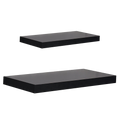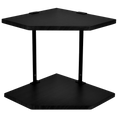- No products in the cart.



More information on Maple:

The hard maple is the state tree of Wisconsin, Vermont, New York, and West Virginia. In the North, during the cold nights and warm days of late winter, the sugar maple is tapped for its sucrose-containing sap, the source of maple syrup. It may take up to 30 gallons of sap to make one gallon of syrup. Early American settlers used maple ashes to make soap and Native Americans crafted their spears from hard maple. Until the turn of the century, the heels of women's shoes were made from maple. Maple has been a favorite of American furniture makers since early Colonial days. Hard maple is the standard wood for cutting boards because it imparts no taste to food and holds up well.
Where it Grows
Eastern U.S., principally Mid-Atlantic and Lake states. A cold weather tree favoring a more northerly climate, its average height is 130 feet.
Main Uses
Flooring, furniture, paneling, ballroom and gymnasium floors, kitchen cabinets, worktops, table tops, butchers blocks, toys, kitchenware, and millwork: stairs, handrails, moldings, and doors.
General Description
The sapwood is creamy white with a slight reddish brown tinge and the heartwood varies from light to dark reddish brown. The amount of darker brown heartwood can vary significantly according to growing region. Both sapwood and heartwood can contain pith fleck. The wood has a close fine, uniform texture and is generally straight-grained, but it can also occur as "curly," "fiddleback," and "birds-eye" figure.
Working Properties
Hard maple dries slowly with high shrinkage, so it can be susceptible to movement in performance. Pre-boring is recommended when nailing and screwing. With care, it machines well, turns well, glues satisfactorily, and can be stained to an outstanding finish. Polishes well and is suitable for enamel finishes and brown tones.
Physical Properties
The wood is hard and heavy with good strength properties, in particular, it's high resistance to abrasion and wears. It also has good steam-bending properties.
You may also be interested in following Floor Registers:
Red Oak Floor Registers White Oak Floor Registers
Hickory Floor Registers American Cherry Floor Registers
American Walnut Floor Registers Brazilian Cherry Foor Registers
Brazilian Walnut Floor Registers Santos Mahogany Floor Registers
More information on Maple:

The hard maple is the state tree of Wisconsin, Vermont, New York, and West Virginia. In the North, during the cold nights and warm days of late winter, the sugar maple is tapped for its sucrose-containing sap, the source of maple syrup. It may take up to 30 gallons of sap to make one gallon of syrup. Early American settlers used maple ashes to make soap and Native Americans crafted their spears from hard maple. Until the turn of the century, the heels of women's shoes were made from maple. Maple has been a favorite of American furniture makers since early Colonial days. Hard maple is the standard wood for cutting boards because it imparts no taste to food and holds up well.
Where it Grows
Eastern U.S., principally Mid-Atlantic and Lake states. A cold weather tree favoring a more northerly climate, its average height is 130 feet.
Main Uses
Flooring, furniture, paneling, ballroom and gymnasium floors, kitchen cabinets, worktops, table tops, butchers blocks, toys, kitchenware, and millwork: stairs, handrails, moldings, and doors.
General Description
The sapwood is creamy white with a slight reddish brown tinge and the heartwood varies from light to dark reddish brown. The amount of darker brown heartwood can vary significantly according to growing region. Both sapwood and heartwood can contain pith fleck. The wood has a close fine, uniform texture and is generally straight-grained, but it can also occur as "curly," "fiddleback," and "birds-eye" figure.
Working Properties
Hard maple dries slowly with high shrinkage, so it can be susceptible to movement in performance. Pre-boring is recommended when nailing and screwing. With care, it machines well, turns well, glues satisfactorily, and can be stained to an outstanding finish. Polishes well and is suitable for enamel finishes and brown tones.
Physical Properties
The wood is hard and heavy with good strength properties, in particular, it's high resistance to abrasion and wears. It also has good steam-bending properties.
You may also be interested in following Floor Registers:
Red Oak Floor Registers White Oak Floor Registers
Hickory Floor Registers American Cherry Floor Registers
American Walnut Floor Registers Brazilian Cherry Foor Registers
Brazilian Walnut Floor Registers Santos Mahogany Floor Registers